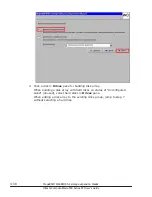
Note: Do not change the disk array during system operations. If you
change the disk array, all data will be lost from those disks due to change in
the disk array.
Note: Set each item to the recommended value unless otherwise specific
directions are given. If not, the system may not properly operate.
Building disk arrays
This section describes the procedure for building new disk arrays.
Building disk arrays for RAID 0, 1, 5, 6
This section describes the procedure for building new disk arrays for RAID 0,
1, 5, and 6.
Note: RAID0 with a single disk does not have redundancy. When an error
occurs in a disk, all data in the disk may be lost. We recommend that RAID1/
RAID5/ RAID6/ RAID10 should be created to improve fault tolerance with
data redundancy.
Tip: To build RAID 10, refer to
Table 4-15 Number of disks required on page
. For how to set hotspare, refer to
Setting Hotspares on page 4-65
.
1
.
Click Configuration Wizard in the main menu.
2
.
Click New Configuration or Add Configuration box, and then click
Next.
4-28
MegaRAID WebBIOS for storage expansion blades
Hitachi Compute Blade 500 Series EFI User's Guide
Summary of Contents for Compute Blade 500 Series
Page 8: ...viii Hitachi Compute Blade 500 Series EFI User s Guide ...
Page 14: ...xiv Preface Hitachi Compute Blade 500 Series EFI User s Guide ...
Page 445: ...SAS configuration utility 7 11 Hitachi Compute Blade 500 Series EFI User s Guide ...
Page 468: ...7 34 SAS configuration utility Hitachi Compute Blade 500 Series EFI User s Guide ...
Page 475: ...BIOS settings for PXE boot 8 7 Hitachi Compute Blade 500 Series EFI User s Guide ...
Page 476: ...8 8 BIOS settings for PXE boot Hitachi Compute Blade 500 Series EFI User s Guide ...
Page 504: ...10 12 Fibre channel over Ethernet FCoE Hitachi Compute Blade 500 Series EFI User s Guide ...
Page 505: ...Hitachi Compute Blade 500 Series EFI User s Guide ...






























